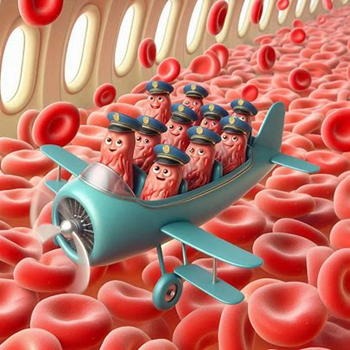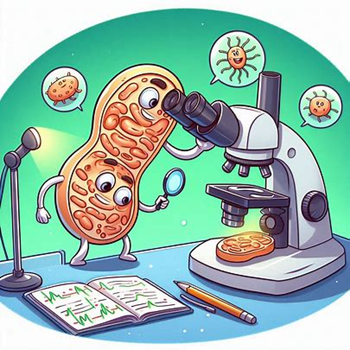Hill Lab
We are an interdisciplinary team seeking to understand how proteins regulate mitochondrial homeostasis in healthy and diseased cells. Currently, we are focused on proteins involved in mitochondrial fission and fusion as well as proteins that interact with mitochondria during apoptosis. Our work contributes to understanding the basic biology, chemistry, and physics of protein-protein and protein-membrane interactions that underlie these signaling pathways and are important in human disease.

Blake Hill, PhD
Professor and Chair
Department of Pharmaceutical Sciences
What is the molecular basis of mitochondrial disease?
My laboratory is investigating the fundamental events that regulate mitochondrial homeostasis in disease (Fig. 1). Our goal is to determine how proteins interact with other biological macromolecules to control these basic processes in healthy cells and go awry to cause disease. We strive to understand these interactions on a physicochemical level, with an eye for gleaning universal principles of protein chemistry including interactions with membrane bilayers that are fundamental to a wide variety of cellular processes. These interactions are likely governed by evolutionarily conserved mechanisms that are still poorly understood. Here we briefly highlight a subset of our past accomplishments with current and future priorities.

Figure 1. Mitochondrial homeostasis is governed by frequent fission and fusion that are central to human health.
Mechanisms of mitochondrial fission and fusion: Implications for neurodegeneration, cardiomyopathies, and death
Frequent mitochondrial fission and fusion events have been appreciated for over a century1, but the genes involved have only recently been identified2. Mutations in fusion genes in humans cause neurodegenerative diseases3 and mutations in fission genes cause neonatal lethality in humans4 and severe cardiomyopathy in mice5,6. These diseases highlight the importance of mitochondrial fission and fusion to human health. Yet how proteins carry out these membrane-remodeling events and respond to their environments to regulate mitochondrial homeostasis is not known. To address these questions, we have initially focused on determining the molecular basis of mitochondrial fission, although we expect our studies will uncover mechanistic connections with other mitochondrial and cellular processes. We investigate these questions using interdisciplinary approaches in yeast 7-15, worm16-18, and mammalian19-25 systems in order to clarify which regulatory mechanisms are evolutionarily conserved and most important.
Lethal mutation in fission mechanoenzyme Drp1 impairs its assembly and localization
Only two proteins are conserved for fission in all species that contain mitochondria: the membrane-anchored Fis1 and the dynamin-related mechanoenzyme Drp1. In mammalian cells, we have determined that disease-causing mutations in Drp1 impair its assembly leading to decreased fission and altered cellular distribution of elongated mitochondria 23. Using a structure-based design approach, we have identified that Drp1 binding to Fis1 is auto-inhibited7-8,25, consistent with our earlier prediction derived from x-ray crystallography and NMR spectroscopy9,11,19. Identifying what relieves Fis1 auto-inhibition and the role of mito-ER tethering in this process is a current focus. A high priority for the future is to determine how these morphological changes exactly impair mitochondrial function to cause disease. These efforts will benefit from our high-throughput screening of small molecule libraries, which should identify useful chemical biological tools for manipulating mitochondrial morphology and may also identify new therapeutic routes.
Defective regulation of mitochondrial apoptosis
Mitochondria dramatically fragment during a form of programmed cell death called apoptosis, which is regulated by the Bcl-2 (B cell lymphoma 2) proteins that, like Drp1, cycle between cytoplasmic and mitochondrial localization's. Down-regulation of either Fis1 or Drp1 prevents mitochondrial fragmentation and delays the onset of apoptosis, but the mechanistic basis of these observations and their functional importance are unclear26 despite the clear importance of apoptosis to human health. Our work to address these questions has focused on Bcl-2 proteins and the interplay with the fission/fusion machinery.
Bcl-2s do more than regulate apoptosis
We were the first to show that Bcl-2 proteins have two separable functions: one in regulating apoptosis and another in regulating mitochondrial fission and fusion16,17. We started by exploring human Bcl-xL20-22, but a major complication in the mammalian Bcl-2 field is the redundancy of Bcl-2 family members. We bypassed these issues by working with the nematode C. elegans, which contains only one Bcl-2 member, CED-9. We designed two new apoptosis assays in the worm that allowed us to replace the endogenous copy of CED-9 with any variant16. This simple, yet powerful, approach had not been taken before in the apoptosis field. We first tested the role of the C-terminal transmembrane domain that across species is evolutionarily conserved and found it was required for mitochondrial localization, but dispensable for apoptosis. This surprising result suggested an evolutionarily conserved role for Bcl-2 proteins at mitochondria distinct from apoptosis, which we (and others27,28) subsequently showed was to regulate the fission and fusion mechanoenzymes17.
Impacting fields beyond mitochondrial homeostasis
Devising a high-throughput screen to dissect complex proteins-proteins interactions
In thinking about complex protein-protein interactions such as those that govern mitochondrial fission and apoptosis, we realized a need to quickly identify alleles that could parse out different interactions and possibly separate different functions. To accomplish this, we conceived a new screen to identify critical residues of one protein that interacts with several others. We have applied this technology to Fis1, rapidly screened >3000 mutations, and simultaneously identified >300 alleles of Fis1 that selectively disrupt yeast two-hybrid interactions between three binding partners13. Our analysis has identified new, functionally important residues of Fis1 that will be critical for dissecting its role in fission. More generally, we think the application of this new screening technology, which we call hotspot (for identifying protein-protein interaction hotspots), can help address how amino acid sequence specifies certain interactions over others. We anticipate that this technology will also gain widespread use to define critical residues between protein complexes in vivo.
Protein amphitropism in mitochondrial biology
For proteins described above, a key feature is the structural transformation from soluble to membrane-bound conformations of proteins, a phenomenon referred to as amphitropism27. Associating with or dissociating from a membrane (i.e. amphitropism) has significant functional consequences for numerous biological processes: it can affect enzymatic activity (CCT, PLC), can promote changes in organelle and cell morphology (minD, dynamins), or can act as a regulatory switch in various signaling cascades (PKC, ESCRTs). However, neither what drives proteins to reversibly interact with membranes nor how this function controls biological outcomes are clearly understood. We anticipate that many more soluble proteins exhibit functional amphitropism and have devised proteomic-based screens to identify these proteins, which will allow us to begin to formulate predictive algorithms as we continue to establish this nascent field.

Figure 2. Proteins that reversibly interact with membranes are amphitropic, which can be assisted (lipid- or cation-dependent) or unassisted (oligomerization- or pH-dependent). The different mechanisms of unassisted aphitropism and how they are regulated are not well known, but will be aided by two proteomic screens we are currently pursuing.
Literature cited. Kyle Ross, Graduate Student
Kyle Ross, Graduate Student
 Amanda Travis, Lab Manager
Amanda Travis, Lab Manager
 Micaela Young, Professional Research Assistant
Micaela Young, Professional Research Assistant
Have you ever wondered what mitochondria do in their free time? Well our PRA, Micaela Young did and with the help of AI she created these snapshots of mitochondria living their best lives.









Loading items....